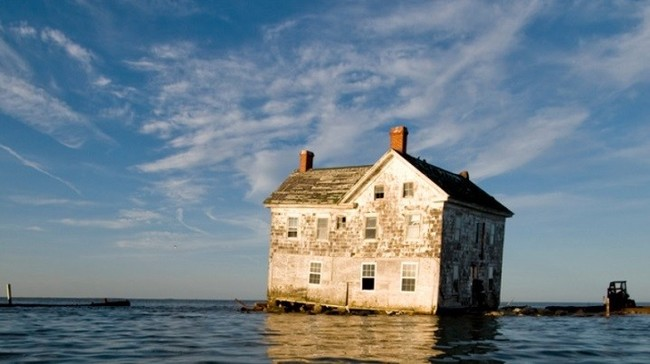Photos Of Abandoned Places Around The World That Reveal The Beauty And Eeriness Of Nature's Reclamation
In the grand cycle of life, there's a mesmerizing phenomenon where nature steps forward to reclaim abandoned places once inhabited by humans. Picture forgotten corners of the world where lush greenery drapes over forgotten structures, and wildlife takes residence in what was once bustling with human activity.
Just like any gardener understands, nature can flourish in even the tiniest spaces – offer her an inch, and she'll conquer an entire mile. Leave your allotment without tending for a few days, and it'll seem like you've been gone for ages, with weeds taking over the beds in no time.
In today's post, we'll see places from around the globe offer a glimpse into this captivating phenomenon—a peculiar beauty where civilization fades into the background, and nature paints a new masterpiece. It's a timeless tale of resilience and transformation, where the passage of time blurs the lines between past and present.
As nature slowly but surely erases the footprints of human existence, it offers a glimpse into a possible future where the Earth reclaims its own. It's both eerie and enchanting, inviting us to ponder — the things we build don't last forever, but nature always finds a way to keep going strong.
We curated different photos, where the strange beauty of nature takes over abandoned places. It's a bit freaky, sure, but also undeniably fascinating — like flipping through the pages of a novel where the ending remains unwritten, and nature holds the pen.
An abandoned shopping mall in Bangkok, Thailand
 via dailymail.co.uk
via dailymail.co.ukThe New World Shopping Mall, left deserted since 1999, was closed down following condemnation by local authorities.
After a few years, a destructive fire ravaged its roof a few years later. Shortly after, monsoon rains inundated the lower levels.
 via dailymail.co.uk
via dailymail.co.ukTo tackle the proliferation of mosquitoes and other insects in the stagnant water, residents introduced koi and catfish to the abandoned mall.
Not only did the fish effectively address the pest issue, but they also flourished, transforming it into one of the largest urban ponds in the planet.
 via dailymail.co.uk
via dailymail.co.ukHolland Island in Chesapeake Bay, Maryland
 Reddit
RedditHolland Island was once a bustling place.
Now, it is deserted, succumbing to rapid erosion. In its heyday, the island was home to approximately 360 residents. However, in 1914, the relentless forces of wind and tide initiated the erosion of its western side, where most of the population resided, compelling them to evacuate.
The image shows the final standing house from Holland Island, which tragically collapsed in 2010.
 Reddit
RedditAbandoned residences in rural Finland.
 via nationalgeographic.com
via nationalgeographic.comFollowing the demise of the property owner in a fire, these cottages were left abandoned.
 via nationalgeographic.com
via nationalgeographic.comNature wasted no time and swiftly started reclaiming the land.
 via nationalgeographic.com
via nationalgeographic.com
Chernobyl Nuclear Power Plant in Ukraine.
 ap
ap
Since the 1986 nuclear disaster at the Chernobyl power plant, the surrounding area has been entirely deserted by humans.
A 1,000-mile zone around the plant remains closed to human activity for the next 20,000 years due to residual radiation from the meltdown. In the absence of human presence, the surrounding forests of Chernobyl have gradually reclaimed the abandoned city.
It's reminiscent of a nuclear wildlife sanctuary. Take a look at these before and after pictures of the area.
 via abandonedkansai.com
via abandonedkansai.com
This was how the power plant was in the '90s
 via Kyiv Post
via Kyiv Post
See this aerial photo from 2013. Notice how the forest is encroaching on the city.
 Alex Cheban
Alex Cheban
Old poison gas factory in Okunoshima, Japan
 littleaesthete.com
littleaesthete.com
Back in World War II, the island of Okunoshima was home to some big poison gas factories.
 via msn
via msn
But after the war, the factories got wrecked and left behind.
The rabbits they used for testing? Well, they got set free around the place.
And guess what? They've done pretty darn well for themselves, as you can see in these photos.
 via gethiroshima.com
via gethiroshima.com
Here's a super cute video from a tourist's visit to the island.
Kolmanskop, a ghost town in Namibia.
 Raymond June from Washington, D.C.
Raymond June from Washington, D.C.
The town was a bustling diamond mining area.
But when the mines ran dry, folks packed up and left in 1954.
 CHRIS GRAY
CHRIS GRAY
Now, Mother Nature's reclaiming the place, turning it back into desert as we speak!
 via ejphoto.com
via ejphoto.com
Aral Desert in Khazakstan and Uzbekistan
 © Arian Zwegers/Flickr
© Arian Zwegers/Flickr
Ever wondered why there are boats in the desert? Well, believe it or not, this wasn't always a desert.
Once upon a time, it was home to the fourth largest body of water in the world.
 Unknown
Unknown
But due to overfishing and irrigation, that grand sea got shrunk down to just 10% of its original size.
What's left now? Three small lakes surrounded by a whole lot of desert. Oh, and plenty of camels roaming around too!
 via Facebook
via Facebook
Fukushima, Japan
 via observer.com
via observer.com
When the Fukushima nuclear disaster struck in 2011, thousands had to evacuate, leaving their pets behind — roughly 10,000 of them!
 AP
AP
There's a foundation in Japan that makes sure to bring food to the city for these abandoned furry friends.
 Unknown
Unknown
Año Nuevo Island in California, USA.
 via Flickr
via Flickr
Out there off the coast of Northern California sits this quaint nine-acre island.
 via onegreenplanet.org
via onegreenplanet.org
It's been deserted since the early 19th century.
And hey, this isn't the only spot where nature's taking back abandoned areas, either.
 via onegreenplanet.org
via onegreenplanet.org
And likely because it's become a prime spot for sea lions and seabirds to breed.
 via lighthousefriends.com
via lighthousefriends.com
Here are some other places reclaimed by nature.
In Berlin, Germany, there's an abandoned amusement park.
 via imgur.com
via imgur.com
Bennett College. It was abandoned in 1978.
 via TheUnknownCameraman
via TheUnknownCameraman
The forest is reclaiming this house.
 Unknown
Unknown
No more railroad tracks. Only nature.
 Unknown
Unknown
A rural Pennsylvania road being reclaimed by Mother Nature.
 Unknown
Unknown
Nature calls — literally
 via Pinterest
via Pinterest
North Border Island (New York)
 via BBC
via BBC
These photos show how nature takes back what was once ours. Even the strongest of structures stand no chance from the power of time, weather, and the force of Mother Nature.
It's a reminder that in the grand scheme of things, everything returns to the Earth. If you have nature-loving friends, go tell them about this post!




